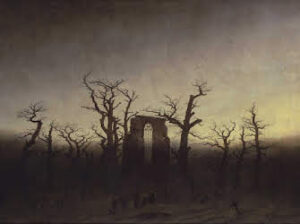Greetings everyone,
The piece of German artwork that I wanted to focus on was discussed in our German Environments class earlier this semester. The work is called “Abtei im Eichwald” (The Abbey in the Oakwood). The painting is by Caspar David Friedrich, who is a very well-known German artist from his time. The painting comes from the German Romanticism period and was painted from 1809-1810. The dark theme with the twisting trees around the crumbling abbey in the center really gives the painting an eerie feeling to it. The relation to German environments is that the painting highlights some important features that have been important to German culture. Specifically, the ‘woodland’ that the painting is located in highlights the background fear and curiosity that exists about the forest in German culture at the time. This can be shown through other fairy tales like Snow White and Little Red Riding Hood, which all had some purpose of fear/mystery within a forested environment of some sort. Just like these fairy tales, the painting shows the viewer that the suspicion and curiosity towards forested environments in Germany have been embedded in the culture for a long period of time.
I think that we can learn quite a bit from this artwork. I think that the crumbling abbey could possibly symbolize a sanctuary for the individuals who are walking toward the entrance. It also appears that the graves that are located around it help illustrate the abandoned feeling that is projected due to their unmaintained appearance. With the abbey placed in the middle of the twisted trees, it almost makes me feel like it is the only safe place for an individual in that environment, while it is surrounded by the darknesses that come from the forest. Also, with the light on the horizon in the painting, I hypothesize that there are safety or better times ahead. While it seems that the individuals who are walking to the abbey are not looking quite happy in the dark environment that surrounds them, it appears to show that the light of the day (and probably a happier, improved environment) is not too far off from the time that the scene takes place.
Overall, I think that the painting helps with illustrating to the observer the cultural context of religion and the forest among Germans. I do think, however, that a person who does not possess the cultural context of the painting may interpret it in a completely different manner.

